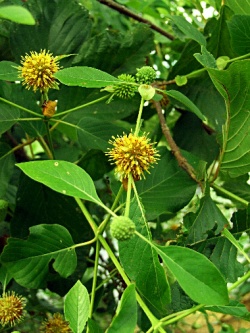Kratom
Other Names : Mitragyna speciosa, ketum, kratum, korth, Thais: กระท่อม
Kratom is a tropical evergreen tree in the coffee family (Rubiaceae) native to Southeast Asia in the Indochina and Malaysia phytochoria (botanical regions). M. speciosa is indigenous to Thailand, Indonesia, and Malaysia, Myanmar, and Papua New Guinea. Kratom has some opiate and stimulant like properties.
Special Precautions of Kratom
Consumption of Kratom does have possible side effects such as nausea, constipation, sleep problems, and temporary erectile dysfunction. Extensive use can cause some problems such as insomnia, anorexia, weight loss, darkening of skin, and dry mouth. There are reports of a small number of Kratom users in South-East Asia experiencing more severe problems from they're extensive consumption of the plant. Problems such as hallucinations, delusional behavior, aggression and schizophrenia seemed to plague some users. Some of these users were also using drugs such as alcohol, opiates and amphetamines as well. Any one of these drugs could have caused these severe symptoms, so it would be questionable to assume that Kratom caused these problems. Some of the people who did not use other drugs did display symptoms, but these were long time users, some as much as 40 years of daily heavy consumption. It seems unlikely that users outside South-East Asia face the same risks, as most recreational users don't consume anywhere near the same amount of Kratom as people from South-East Asia. It is recommended that new Kratom users start with smaller doses to avoid potential negative effects. Avoid driving and operating heavy machinery. Use caution when mixing psychoactive substances with Kratom. There appears to be no information regarding Kratom use and interactions with MAOI’s and SSRI’s, but if you take MAOI’s, do not use Kratom. People taking SSRI’s are advised to use caution when taking Kratom. Most people taking SSRI’s report no problems with Kratom. As far as addiction, almost any psychoactive substance can be habit forming, and Kratom is no exception. Unlike opiates, however, Kratom does not produce a strong addiction, especially at doses generally taken outside South-East Asia. Though a tolerance can easily be built, the body does not seem to crave Kratom, or any of its active alkaloids. After prolonged use, some minor withdrawal symptoms can be noticed such as runny nose, aggression and slight muscle pains.
The benefits of Kratom are
Mitragyna speciosa, also known as "kratom," is a plant native to the rainforests of Southeast Asia that has long been used in traditional herbal medicine to treat pain, boost energy, alleviate anxiety and depression symptoms, and promote feelings of wellness and happiness. But because the plant allegedly exhibits opioid-like activity, the U.S. Drug Enforcement Administration (DEA) has placed it on its infamous Drugs and Chemicals of Concern list, which indicates that the agency may eventually try to ban kratom in the U.S.
Kratom's users swear by its medicinal properties, insisting that it is safer and more effective than prescription painkillers like Vicodin (acetaminophen and hydrocodone) and morphine, and far less addictive. But the DEA is treating kratom as if it was a highly-dangerous drug capable of causing severe harm. So is kratom safe and effective, or is it dangerous?
Based on the limited data that is available on kratom, it appears as though the actual plant extract itself is basically safe, and that the DEA is simply overreacting. Even in its own warning, the DEA notes that the main problems associated with kratom have to do with it being abused, and typically in conjunction with other chemicals and additives. By itself, in other words, there appears to be no legitimate evidence showing that kratom is in any way dangerous.
You can learn a little more about kratom, including its potential dangers, by visiting: http://www.kratom.com/
Kratom appears safer and more effective than pharmaceutical drugs at treating chronic pain
A 1988 study published in the Journal of Ethnopharmacology found that two of the more than 25 naturally-occurring alkaloids found in kratom leaves -- mitragynine and 7-hydroxymitragynine -- exhibit opiate-like effects in animals. And yet these two compounds merely act on opiate receptors, and in a much less severe way than, say, morphine, which is highly addictive and potentially deadly (http://www.phoenixnewtimes.com).
On the other hand, kratom users say the herb helps them live vibrant, pain-free lives without causing any harmful side effects. And most reports, though anecdotal, claim that any potential addiction to kratom is mild and easily mitigated. So who are we to trust, actual users or the DEA?
Unless it can be proven, without a doubt, that kratom is in any way dangerous, the federal government has no business trying to ban it. And even then, caution must be taken to ensure that kratom does not go the way of marijuana, which continues to remain an illegal, controlled substance despite the fact that it is a proven medicinal herb with little or no negative side effects.
Kratom has already been banned in Indiana, but it remains legal in the other 49 U.S. states. And in the interests of preserving health freedom for the thousands of kratom users that choose of their own free will to use this herb as treatment, it is important to be on the lookout for any legislation that might threaten to outlaw this natural medicine.
